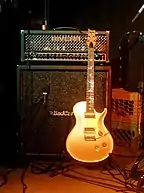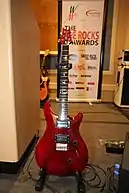PRS Guitars
Paul Reed Smith Guitars, also known as PRS Guitars, is an American guitar and amplifier manufacturer located in Stevensville, Maryland. Founded in 1985 in Annapolis, Maryland by Paul Reed Smith.
 | |
| Type | Private |
|---|---|
| Industry | Musical instruments |
| Founded | 1985 |
| Founder | Paul Reed Smith |
| Headquarters | , |
Area served | Worldwide |
Key people | Paul Reed Smith |
| Products | Electric & acoustic guitars, basses, amplifiers |
| Website | prsguitars.com |
Products currently manufactured by PRS include electric & acoustic guitars, basses, and amplifiers.
History
Beginning: 1985-1995
Paul Reed Smith set up a partnership to create a factory in Annapolis, Maryland.[1] and set off work on producing guitars. The company's first outing was for the 1985 NAMM Show where they debuted the PRS Custom. Featuring a mahogany neck set into a mahogany body with a maple cap, a patented vibrato, customized tuning pegs, and custom rotary pickup switching with high quality electronics, the guitar represented influences from both old and new; something striking in the midst of an industry that was producing "high tech" guitars. "I saw Adrian Belew on King Crimson's Beat tour in 1982," says Smith, "and the sound he was getting out of his guitar was on another planet somewhere. He let me rebuild his Ibanez Blazer. I put in our whole tuning-peg/bridge system and a new electronic system with an Alembic Stratoblaster pre-amp. It sounded unbelievable. Right then I decided that I wanted to put those sounds on a humbucking guitar, which is when I went back to the rotary switch and redesigned it for humbuckers."[2] After three years, the company employed 45 people, and was producing 15 guitars per day.
Construction
Hardware
Nuts are synthetic and tuners are of PRS's own design, although some models feature Korean-made Kluson-style tuners. PRS guitars feature three original bridge designs: a one-piece pre-intonated stoptail, a vibrato, and a wrapover tailpiece. The vibrato was designed with the help of guitar engineer John Mann. It was an update on the classic Fender vibrato and used cam-locking tuners, which offered wide pitch bending with exceptional tuning stability.[1]
Pickups
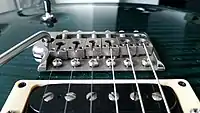
Pickups are designed and wound in-house. While most of the pickups are humbuckers, some are actually a pair of single coils wound in opposing directions, one intended for the neck and one for the bridge position. Through the use of a unique rotary pickup selector switch, PRS pickups offer 5 different sounds: a combination of thick humbucking Gibson-like tones, and chimey single-coil Stratocaster-like tones.[1] The standard treble and standard bass pick ups use magnetic pole pieces in the non-adjustable inner coil, and a rear-placed feeder magnet in order to achieve a more authentic single-coil tone when split by the rotary switch.[1]
PRS developed pickups for the aggressive rock market, offering pick ups such as the chainsaw, and the Hot-Fat-Screams (HFS) initially used on the Special model.[1]
In 1998, an electronic upgrade kit was released for pre-1993 instruments which included lighter-weight tuner buttons, nickel-plated brass screws for saddles and intonation, a simulated tone control, and high-capacitance hookup wire.[1] In 2012, PRS released the 408 pickups used on the 408 and Paul's Guitar models. These pickups include innovations that feature no loss of volume when in coil split mode.[3] They have an exclusive agreement to use wire drawn from the same machine that made wire for Les Paul and Stratocaster pickups in the 1950s.[4]
Certain models of PRS Guitars have also used pickups by Lindy Fralin, notably in the EG II[5] and certain specs of the Custom 22.[6]
Models
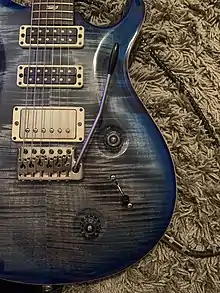
In 1985, Paul Reed Smith started producing factory made guitars, which later on known as PRS Standard.[7]
In 1988, Paul Reed Smith introduced its more affordable Bolt-On series known as classic electric(CE models,) which discontinued in 2009. In 2016, the CE line was put back in production.[8]
In 1990, PRS EG was introduced as company's first 22-fret guitar. Later on in the more successful 1992 PRS EG II was introduced, which includes PRS's first lefty guitar.[7]
In 1992, PRS introduced the Dragon 1 model. Only 50 units were produced. It featured an intricate dragon inlay which ran down the finger board, a wide 22 fret neck, and a non-vibrato Stop-tail bridge and a new pick up design. The changes in design from previous models added a noticeable tonal improvement which led the company to use the same characteristics in later models such as the PRS Custom 22.[1] The Dragon 2 was released in 1993, and the Dragon 3 in 1994. Both featured dragon inlays which became more extreme with every year. Only 100 of each of the 2 models were made.[1] In 1999, PRS released the Dragon 2000, which featured complex body curves, and a 3 dimensional dragon inlay. Just 50 Dragon 2000's were ever produced.[1]
In 1994, Paul Reed Smith collaborated with Ted McCarty and launched the "McCarty" Series. The McCarty series offers a more vintage feeling and sounding PRS Guitar.[7]
PRS introduced a more affordable line of guitars in 2000[9] referred to as the "SE" which are manufactured in Korea by World Musical Instrument Co. Ltd. for the electrics and Wildwood for the acoustics. PRS produces a large range of models in the SE series including the Custom 24, SE245, SE Kestrel and Kingfisher bass guitars as well as signature guitars such as the Bernie Marsden, Tremonti, Zach Myers and Santana amongst others.[10] They also intro their Singlecut models in 2001.
PRS introduces a range of amplifiers and acoustic guitars in 2009.[11][12]
In 2013, PRS added the S2 Series and in February 2018 PRS began producing a Silver Sky model based on two of John Mayer's favourite guitars from the 1960s.[13]
In 2019, PRS announced three SE signature models: PRS SE Santana Singlecut Trem, PRS SE Paul's Guitar, and PRS SE Schizoid.[14]
Legal challenge
In 2001, PRS released their Singlecut model, which resembled the traditional Les Paul. Gibson Guitar Corporation filed a trademark infringement lawsuit against the owner, Paul Reed Smith. An injunction was ordered[15] that required PRS to stop manufacturing of the Singlecut at the end of 2004. Federal District Court Judge William J. Haynes, then ruled the Singlecut was an imitation of the Gibson Les Paul.[15] However, in 2005, the United States Court of Appeals for the Sixth Circuit reversed the lower court decision and ordered the dismissal of Gibson's suit and PRS resumed production.[16]
While no changes to the design of the Singlecut occurred as a result of the lawsuit, some Singlecut owners and sellers have adopted the term 'pre-lawsuit' to differentiate their Singlecut guitar from others.[17][18][19]
References
- Bacon, Tony (2000). Electric guitars, the illustrated encyclopedia. San Diego: thunder bay press. pp. 250–267. ISBN 1-57145-281-8.
- Burrluck, Dave. (2007). The PRS guitar book : [a complete history of Paul Reed Smith guitars] (3rd ed.). Milwaukee, WI: Backbeat. ISBN 978-0879308988. OCLC 71808403.
- "Why Don't PRS 408 Pickups Lose Volume in Single-coil Mode?". Sweetwater. April 16, 2013.
- "PRS Talks PAF Pickups, Wire and 408". MusicStoreLive.com. August 9, 2013 – via youtube.com.
- Buurluck, Dave (2007). The PRS Guitar Book: A Complete History of Paul Reed Smith Guitars. Backbeat Books. p. 151.
- "Model History". prsguitars.com. Retrieved 31 January 2019.
- "NAMM 2019:30 years of PRS: 30 landmark guitars". www.musicradar.com. Retrieved 2019-05-06.
- "Behind the PRS CE: how the Classic Electric guitar returned". www.musicradar.com. Retrieved 2019-05-06.
- "Year Identification". Customer Support Center. www.prsguitars.com. Retrieved 2017-08-30.
- PRS
- Taylor, Mick; September 2008, Chris Vinnicombe 25. "PRS launches new guitars and amp range". MusicRadar.
- August 2011, Guitar World Staff 20. "PRS Guitars Introduces New SE Amp Line". guitarworld.
- "PRS Guitars Announces the John Mayer Silver Sky". www.premierguitar.com.
- "NAMM 2019: PRS Announces Three New SE Signature Models". www.guitarworld.com. Retrieved 2019-05-06.
- Gibson Guitar Corp. v. Paul Reed Smith Guitars, L.P., 325 F. Supp. 2d 841 (M.D. Tenn., 2004)
- Gibson Guitar Corp. v. Paul Reed Smith Guitars, LP, 423 F.3d 539 (6th Cir. 2005).
- Gibson Guitar Corp. v. Paul Reed Smith Guitars, LP, 423 F.3d 539 (6th Cir. 2005), footnote 13.
- Marchisotto, Paul Anthony (2006). "Note: Gibson v. PRS: the Applicability of the Initial Interest Confusion Doctrine to Trademarked Product Shapes". Cardozo Arts & Entertainment Law Journal. 24: 883–917.
- Haggerty, Thomas P. (2006). "Note: A Blue Note: The Sixth Circuit, Product Design and the Confusion". Cite journal requires
|journal=(help)
External links
| Wikimedia Commons has media related to PRS guitars. |
- Official website
- Paul Reed Smith Interview NAMM Oral History Library (2013)
.jpg.webp)
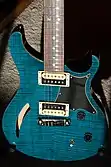
.jpg.webp)
%252C_PRS_Custom_(1988)_-_MIM_PHX.jpg.webp)
